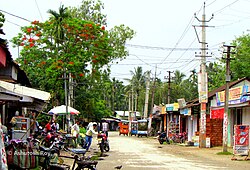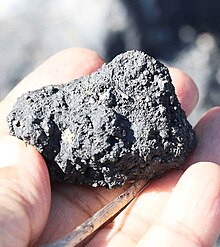Chirang district
Chirang | |
|---|---|
 Dewkurapaar market in Bijni | |
 Location in Assam | |
| Coordinates (Kajalgaon): 26°35′N 90°37′E / 26.58°N 90.61°E | |
| Country | |
| State | |
| Territorial Region | |
| Established | 2004 |
| Headquarters | Kajalgaon |
| Government | |
| • Lok Sabha constituencies | Kokrajhar (shared with Kokrajhar district) |
| • Vidhan Sabha constituencies | Sidli, Bijni |
| Area | |
| • Total | 1,169.9 km2 (451.7 sq mi) |
| Population (2001) | |
| • Total | 482,162 |
| • Density | 410/km2 (1,100/sq mi) |
| Boro | |
| Time zone | UTC+05:30 (IST) |
| Major highways | 27 |
| Notable educational institutions | |
| Website | chirang |
Chirang District is an administrative district in the Bodoland Territorial Region of Assam state in the North-East of India.[1]
Etymology
The word "Chirang" has derived from Garo word – "chi" means water and "rang" means "rain".[2] It may also be a copy of Tsirang District of neighbouring Bhutan. On the other hand, most of the people regarded the word Chirang is derived from the Bodo word Chirang or Sirang. Si means life and Rang means Money.
History
Duars
Chirang district falls under the Eastern Duars which includes the region between the Sankosh river and the Manas river. Guma, Bijni and Chirang Dooars are three important Dooars in Chirang district.[3]
Present
It is a relatively new district in the Bodoland Territorial Region of Assam. Chirang district has been carved out from Bongaigaon district in 2004.[4] Sirang was an area which is covered by valuable soil, plants, trees, flora and fauna or the things which are necessary for human life. Thus, it is a place which is important for human life or the place which is just like money or valuable for life and is later come to know Si + Rang = Sirang. After some time, the word articulated to Chirang from Sirang. And thus, the word Sirang is latter known as Chirang.[citation needed]
Geography
Chirang is located in the lower part of Assam.It is located between longitudes 26.58°N (North) 90.61°E(East). The Chirang region has a plain geology. It additionally has undulating regions and the northern pieces of the area lie on the lower regions of Bhutan that has somewhat higher height, which is diminishing towards the southern pieces of the locale. The four sorts of soil found here are Entisols, Inceptisols, Alfisols and Ultisols. The region goes under Lower Brahmaputra Valley Agro-Climatic Zone. The environment is sub-tropical in nature with warm and sticky summer followed by dry and cool winter. The pre and post-storm months are eccentric and experience whimsical precipitation. Champabati River,Aie River and Manas River move through the area and join the Brahmaputra Waterway. Numerous different feeders, little creeks and streams course through locale.[citation needed]
National protected area-
- Manas National Park (Part) - protected area.
Flora and fauna-
In 1990 Chirang district became home to Manas National Park, which has an area of 500 km2 (193.1 sq mi).[5] It shares the park with four other districts.
Climate
Chirang has a moderate climate. There is a lot of rainfall in the summer, and in the winter it is quite dry again. The average annual temperature for Chirang is 33° (degrees)and there is about 248 mm of rain in a year. It is dry for 282 days a year with an average humidity of 42% and an UV-index.[6]
Demographics
| Year | Pop. | ±% p.a. |
|---|---|---|
| 1901 | 37,523 | — |
| 1911 | 48,731 | +2.65% |
| 1921 | 61,885 | +2.42% |
| 1931 | 71,977 | +1.52% |
| 1941 | 82,972 | +1.43% |
| 1951 | 90,797 | +0.91% |
| 1961 | 165,829 | +6.21% |
| 1971 | 247,085 | +4.07% |
| 1991 | 437,288 | +2.90% |
| 2001 | 433,061 | −0.10% |
| 2011 | 482,162 | +1.08% |
| source:[7] | ||
According to the 2011 census Chirang district has a population of 482,162,[8] roughly equal to the nation of Suriname.[9] This gives it a ranking of 547th in India (out of a total of 640).[8] The district has a population density of 244 inhabitants per square kilometre (630/sq mi) .[8] Its population growth rate over the decade 2001-2011 was 11.26%.[8] Chirang has a sex ratio of 969 females for every 1000 males,[8] and a literacy rate of 64.71%. 7.33% of the population lives in urban areas. Scheduled Castes and Scheduled Tribes make up 7.29% and 37.06% of the population respectively.[8]
Religion
Hindus make up the majority, with 66.50%. Muslims are the second largest with 22.66%. Christians are third with 10.32%.[10]
Language
According to the 2011 census, 37.83% of the population spoke Boro, 28.86% Bengali, 17.66% Assamese, 4.73% Santali, 4.22% Rajbongshi, 2.51% Nepali, 1.11% Kurukh and 1.06% Hindi as their first language.[11]
Transportation
Gelephu,India-Bhutan International border Gelephu, India-Bhutan crossing Gelephu is 41 km from Kajalgaon, the headquarter of Chirang, 7 km from Bongaigaon, 340 km from Siliguri.[12]
Tourism Gallery




- Mwnabili Picnic spot & Eco Tourism

Mwnabili Evening shadow 
Mwnabili picnic spot - Nizlaguri Nizwra & Eco Tourism Picnic spot
- Aipoali Picnic Spot
- Indo-Bhutan Border Maoria Picnic spot % Eco Tourism
Administration
The district has a headquarters in Kajalgaon. There are 479 revenue villages in the district.
Major Towns-
Township-
Villages-
- Bengtol
- Soulmary
- Patabari (Island)
- Koila Moila
- Panbari
- Subaijhar
- Dadgari
- Gwbwr Bazar
- Laimuti F.V
- Kashikotra
Education
The district has numerous colleges and higher educational institute.[14]
Notable colleges-
All the college's and higher educational institutions are Affiliated to Bodoland University.
Industries
- Bongaigaon Refinery:The third refinery in Assam, located at Dhaligaon.[15]
Rivers
- Manas River
- Aie River

Aie river evening shadow - Lanker River
Notable people
- Pwilao Basumatary,Boxer.[16]
- Prem Singh Brahma,former leader of Bodo Liberation Tigers Force.
- Kamal Singh Narzary,former MLA
- Chandan Brahma, former minister of culture.
References¹
- ^ "Chirang district of BTR–". Retrieved 16 April 2023.
- ^ "Chirang District – Assam". chirang.assam.gov.in. Retrieved 16 April 2023.
- ^ (Das 1998:50–51)
- ^ Law, Gwillim (25 September 2011). "Districts of India". Statoids. Retrieved 11 October 2011.
- ^ Indian Ministry of Forests and Environment. "Protected areas: Assam". Archived from the original on 23 August 2011. Retrieved 25 September 2011.
- ^ "Climate chirang". Retrieved 22 April 2023.
- ^ Decadal Variation In Population Since 1901
- ^ a b c d e f "District Census Handbook: Chirang" (PDF). censusindia.gov.in. Registrar General and Census Commissioner of India. 2011.
- ^ US Directorate of Intelligence. "Country Comparison:Population". Archived from the original on 13 June 2007. Retrieved 1 October 2011.
Suriname 491,989 July 2011 est.
- ^ a b "Table C-01 Population By Religion: Assam". census.gov.in. Registrar General and Census Commissioner of India. 2011.
- ^ a b "Table C-16 Population By Mother Tongue: Assam". censusindia.gov.in. Registrar General and Census Commissioner of India. 2011.
- ^ "Gelephu,India-Bhutan International". Retrieved 22 April 2023.
- ^ "Kalamati tourist". Retrieved 22 April 2023.
- ^ "List of Colleges in Chirang District". Retrieved 23 April 2023.
- ^ "Bongaigaon Refinery". Retrieved 23 April 2023.
- ^ "About the Awardee: Pwilao Basumatary". NDTV. Retrieved 31 July 2021.
References²
- Das, Smriti (1998). Assam Bhutan relations with special reference to duars from 1681 to 1949 (PhD). Guwahati University. hdl:10603/67909. Archived from the original on 16 March 2023. Retrieved 16 April 2023.
- Phuntsho, Karma (2013). The History of Bhutan. Penguin Books. ISBN 9781908323583.




